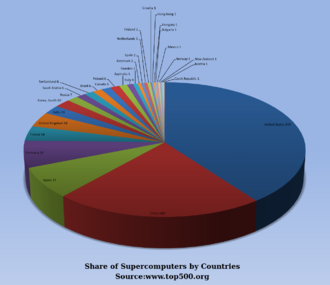Applications

This section is in list format, but may read better as prose. (January 2020) |
This section needs expansion. You can help by adding to it. (January 2020) |
The stages of supercomputer application may be summarized in the following table:
| Decade | Uses and computer involved |
|---|---|
| 1970s | Weather forecasting, aerodynamic research (Cray-1). |
| 1980s | Probabilistic analysis, radiation shielding modeling (CDC Cyber). |
| 1990s | Brute force code breaking (EFF DES cracker). |
| 2000s | 3D nuclear test simulations as a substitute for legal conduct Nuclear Non-Proliferation Treaty (ASCI Q). |
| 2010s | Molecular Dynamics Simulation (Tianhe-1A) |
| 2020s | Scientific research for outbreak prevention/Electrochemical Reaction Research |
The IBM Blue Gene/P computer has been used to simulate a number of artificial neurons equivalent to approximately one percent of a human cerebral cortex, containing 1.6 billion neurons with approximately 9 trillion connections. The same research group also succeeded in using a supercomputer to simulate a number of artificial neurons equivalent to the entirety of a rat's brain.
Modern-day weather forecasting also relies on supercomputers. The National Oceanic and Atmospheric Administration uses supercomputers to crunch hundreds of millions of observations to help make weather forecasts more accurate.
In 2011, the challenges and difficulties in pushing the envelope in supercomputing were underscored by IBM's abandonment of the Blue Waters petascale project.
The Advanced Simulation and Computing Program currently uses supercomputers to maintain and simulate the United States nuclear stockpile.
In early 2020, Coronavirus was front and center in the world. Supercomputers used different simulations to find compounds that could potentially stop the spread. These computers run for tens of hours using multiple paralleled running CPU's to model different processes.
Comments
Post a Comment